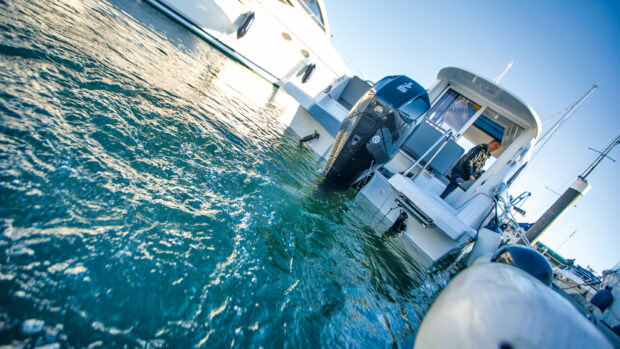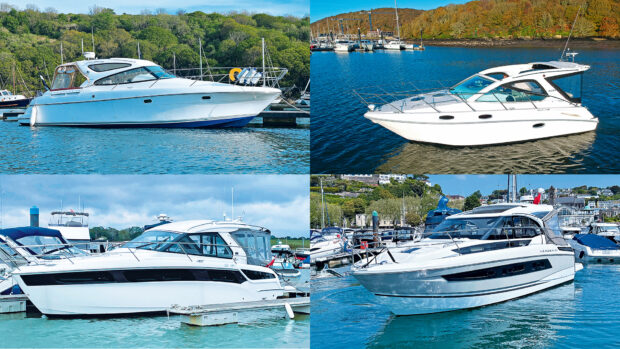Everyone knows the story of Donald Campbell’s tragic crash on Coniston Water but few remember another all-British attempt 15 years earlier. Now a new book reveals what really happened to John Cobb and his jet-powered Crusader...
The fact that only one man has exceeded this speed, and lived, tells you all you need to know. Ken Warby set the world water speed record in 1978, peaking at 345mph and averaging 317.59mph, in a wooden boat hand built by Warby in his back garden.
Thirty-one years on, his record for the world’s fastest boat still stands unbroken, giving some idea of just how difficult and dangerous it is to attain high speeds on water.
But in 1949, some 30 years before Warby’s record-breaking run and 18 years before Donald Campbell lost his life trying to break the same record in Bluebird K7, two other Englishmen were planning an equally daring assault on the record.
 Watch the video
Watch the videoArticle continues below…

Fastest boat: The current holder and contenders for the world water-speed record

How Donald Campbell broke both land and waterspeed records in the same year
John Cobb and Reid Railton: Very British heroes
John Cobb, a wealthy fur broker with almost no experience of fast boats, already held the land speed record of 394.2mph thanks to a revolutionary twin aero-engined car, the Railton Mobil Special, designed by engineering guru Reid Railton.
Now Cobb wanted to capitalise on his success by following the same route as Henry Segrave and Malcolm Campbell before him and taking to the water. His aim was not just to break the world record, which then stood at 141.7mph, but to be the first man to top 200mph on water.
The water speed record is not something to be taken on lightly. Unlike high speeds in a car, on water, the surface is constantly changing. A high speed car fights mainly only aerodynamic drag, whereas a boat has two fronts to combat, aerodynamics and hydrodynamics, so Cobb would have to rely on the design genius of his old friend Reid Railton again.

John Cobb in his Railton land speed record car Photo: Courtesy of Charles Taylor
The concept Railton proposed was like nothing ever seen before but was arrived at by simple, logical development from his previous work on Sir Malcolm Campbell’s Bluebird K3, and Bluebird K4 hydroplanes.
Unlike previous record holders, it would not be powered by piston engines and propellers but by one of the newfangled jet engines that had only recently entered service during the latter stages of WW2.
It would also turn current thinking on its head by having a single planing surface at the front and two stabilising sponsons at the back rather than the other way round. In essence it was like a high speed waterborne tricycle. According to Railton’s calculations this new craft would theoretically be capable of speeds of up to 250mph.

Reid Railton, John Cobb and Peter Du Cane show off a model at the press launch in London
As if that weren’t tricky enough, there was the challenge of getting permission for and finding a yard capable of building such an unconventional craft, especially in post-war Britain when materials were still in short supply. Eventually Vosper took on the task of turning Railton’s thinking into the functioning craft that was to be called Crusader.
After a long and troubled design and research process, construction began. The main hull was built mostly from birch plywood bulkheads, cut from single sheets for strength, and attached to an internal wooden keel made up of several parts.
The un-skinned hull resembled a massive model boat, though this was covered by an outer skin of 1/16th ply sheets cross-laid onto Spruce stringers and covered with ‘doped’ waterproof fabric, producing a type of lightweight wooden monocoque.

Crusader in build at Vosper
Only the highly stressed internal members, such as the engine mounting and supports for the rear sponsons, were made from aluminium alloy and linked to two ring bulkheads of the same material.
But here the construction differed from Railton’s vision, as he had proposed a third ring ahead of the cockpit with horizontal beams linking it to the rear rings, to support the forward planing shoe, mount the rudder and protect the pilot. However, neither the third ring nor the horizontal elements were included in the build.
John Cobb financed the construction himself, giving Vosper a cheque for £15,000 (roughly £500,000 in today’s money), though the project cost him nearer £45,000 (£1.5 million) in total.

Crusader on its way to Loch Ness
Loch Ness Monster
The team arrived at Loch Ness, the chosen venue for the record attempt, in late August 1952. The project manager was Cobb’s friend and land speed rival, George Eyston, who had strong links with the sponsor, Castrol.
He had organised for the team to use the jetty and boat house of Alec Menzies at Temple Pier, Loch Ness, and it was here that the men from Vosper, engine supplier De Havilland, and radio experts PYE set about preparing Crusader for her first run.
This took place on September 3, with Vosper’s Peter du Cane, who had overseen the construction of Crusader, at the helm as John Cobb had a meeting in Inverness.
Du Cane achieved a speed of about 100mph, and noted that the boat was hard to turn at low speed, but also had a tendency to hold her speed even when he closed the throttle. Just as Crusader was about to be lifted out of the water, Cobb returned and decided to undertake a test run himself.
Not only was this the first time he had sat in the cockpit of the boat he had paid for but it would also be the first time he had ever piloted a boat at more than 40mph. The record he was aiming for had now been raised to 178.49mph!
John Cobb made five runs, all at around 100mph, successfully turning at the end of each run. Over the following days, when the weather allowed, he continued to increase his speeds, while attempting to iron out any problems that arose.

Crusader sitting on its cradle
Of these, one was of major concern, the strength of the forward planing surface. Up until this time, the fastest, most up to date water speed record challengers had a single stern planing surface and two forward planing surfaces, separated by a concave bottom to the hull, so that at speed the craft was only touching the water on these three points.
Railton had reversed the layout for Crusader, meaning there was just a single planing surface at the front. This simplified the installation of the Ghost jet engine but increased the loads on the single forward surface, where the third alloy bulkhead should have been.
This forward surface was now showing signs of distorting, to the point where the smallest members of the team were sent into the hull armed with strips of wood and screws to try and reinforce it.

What wasn’t known to many of the team were the changes that had been made to the design during the construction of Crusader that had compromised the hull’s integrity. Added to this, and against the wishes of both Cobb and Railton, Vosper fitted a larger, heavier and untried rudder after the initial test runs to try and make it easier to turn.
The entire process of design, research and construction had proved to be a power struggle between those who had conceived and paid for Crusader, and those charged with her construction, exacerbated by post-war material shortages, convoluted Trans Atlantic communication (Railton was living and working in California), and the conservative construction techniques being employed, all of which were coming home to roost.
Railton insisted on meetings before and after each run to iron out any issues. The meeting of September 12 concentrated on the structural issues facing Crusader and was recorded as being “high powered” but could better be described as fraught and tense.

Crusader is lifted into the Loch’s dark waters. Photo: Courtesy of Julie Newton
The exact details of what was discussed and agreed is not known, despite claims and counter claims of letters being written and signed promising that the craft was capable of taking the record but the speeds would be held back. However, none of this can be substantiated.
What can be accurately stated is that John Cobb was told Crusader could take the record, in perfect conditions, but that Railton had to head back to the US on business and would return the following month for the actual record attempt. In the meantime, only high speed tests would be conducted.
Cobb, sympathetic to the religious beliefs of his hosts, had promised never to run on a Sunday, even though to date Sundays had offered the best conditions. Railton duly departed Loch Ness on Sunday September 28 to make his way south to Southampton to travel to America. Early the next morning, preparations began for a high speed test run.

Vicki Cobb looks into the eyes of her brave husband
To the public, the Crusader project looked no different to any previous record attempt; brave men, fast boats and a supporting team of boffins and engineers.
But behind the scenes at Loch Ness, the personality clashes, errors of judgement and obscure engineering and design decisions had created the perfect scenario for disaster, and by 05:30, September 29 1952, the scene was set.
200mph or bust
The team had been on standby since 04:00 to take advantage of the calm early morning waters, but the smaller support craft returned from their exploratory course run to report that the water conditions at the far end of the measured mile weren’t suitable.

Commander Bray sends the all clear signal to start
As a result, the motor yacht that was meant to have stayed in position at the half mile mark, for timing and the press, returned to Temple Pier just at the time the water conditions settled down to allow a perfect run.
The balance of getting back to position as quickly as possible while allowing time for the wakes left by all these craft to die down put Cobb under needless pressure. Added to this, the roads around Loch Ness were blocked by thousands of spectators who had positioned themselves along the course to watch Crusader, even though no record attempt had been announced.
John Cobb was a reserved character and happiest away from crowds but he was also grateful for the support shown, and now felt pressure to “put on a show” for those that had turned up to see him make a run, regardless of whether the water conditions were ideal or not.

John Cobb stepping across from the support boat with its vast array of starter batteries
At 11:15 Cobb boarded Crusader and ran through the warm-up procedure for the Ghost engine. At 11:49 he accelerated hard toward the measured mile for the first of the two runs in opposite directions needed to establish a new world record.
Crusader quickly got up onto her planing shoes, and having started further away from the measured mile than on previous runs, worked up to a much faster speed than ever before – in the region of 240mph.
As Cobb approached the measured mile it soon became obvious all was not well. Witnesses report seeing Crusader bouncing and vibrating, unable to maintain her stable planing attitude. Then, just as Crusader entered the measured mile, three waves were seen travelling out from the northern shore directly across her path.

John Cobb roars along Loch Ness in his revolutionary jet-powered boat Crusader
The first was struck with what witnesses described as a “pistol like crack”. The engine note dropped, indicating a brief reduction in throttle, before rising again. But Crusader now started to rock from sponson to sponson.
On hitting the second wave, the bow lifted noticeably before dropping back down just as Crusader’s stern hit the third and final wave. As the stern lifted, the bow was pushed even further down. The instant the nose dug in, Crusader seemed to disintegrate into a vast plume of spray and debris. There was a shout of, “He’s over.” Then silence.
Cobb, who had chosen not to wear the craft’s rudimentary safety belt, had been thrown forward out of the cockpit and bounced across the surface of the water, travelling some 150 yards, before finally coming to a halt. When he was pulled from the water, he was already dead, his neck broken.

Photos: Stills from BBC and Movietone News film archives
Cobb’s wife, Vicki, had witnessed the crash from the end of Temple Pier, and was led away to the privacy of the project headquarters, a secondhand caravan parked by the boat house. On the water, there was little left of Crusader; one hatch of three square feet, and a myriad of tiny silver and red shards, all of which were recovered, and at Vicki’s request, burnt that evening.
In the days that followed the Union Internationale Motonautique, which governed the record attempt, took the unusual step of releasing a statement to certify that “Mr John Cobb, piloting Crusader established the following figures on the statute mile on Loch Ness on September 29th 1952, Elapsed time: 17.4 seconds. Speed: 206.89mph. This performance over the mile does not constitute a World’s Record, but is the fastest speed ever obtained on water.”
John Cobb had succeeded in becoming the first man to break 200mph on water but without a return run, could not be awarded the record itself.

What went wrong for John Cobb?
At the time, the disaster, the loss of a speed hero and the total destruction of an experimental boat, was accepted by most as just a tragic accident, the inevitability of pushing boundaries beyond the norm. But behind the scenes, there was ill feeling and thoughts that perhaps mistakes had been made.
Some made much of the three small waves that had appeared and the repairs that had to be made to the boat on site, but with the passing of time, all this was forgotten, it was a brave attempt that simply hadn’t worked.
Now, some 70 years later, and having gathered together as much of the original documentation that still survives during research for my new book, Crusader: John Cobb’s ill-fated quest for speed on water, another story has emerged.

A weakness in the hull, compounded by an enforced high centre of gravity, less than perfect conditions and a pilot keen to “put on a show” for his new found friends, more or less condemned the project to failure, but the seeds had been sown long before the first piece of wood had been cut.
Crash analysis, using the latest techniques, suggested that the hull had actually failed before its final dive into the loch, but of course, there was no way of proving this, until Craig Wallace of Kongsberg Maritime succeeded in the monumental task of finding and filming the remains of Crusader on the bottom of Loch Ness.
She now lies at the bottom of an underwater cliff, missing one sponson, upside down, and broken in two, having shattered at the cockpit area, just at the point the third alloy bulkhead should have been.

‘Crusader: John Cobb’s ill-fated quest’ book review
-Hugo Andreae
As a self-confessed world-waterspeed-record geek, I can’t get enough of books about the subject, especially when they bring fresh evidence to light about how and why some of the more heroic attempts ended in failure.
Steve Holter’s new book is a genuine tour de force, painstakingly sifting through old archives, freshly discovered source material and modern crash analysis techniques to piece together the story of Crusader’s development, the people behind her and her tragic final run.
It can be a little dense at times and errs on the scientific side rather than the human tragedy and drama of the record attempt but that’s also part of what makes it so appealing to WSR anoraks like me.
Buy Crusader: John Cobb’s ill-fated quest for speed on water on Amazon (UK)
Note: We may earn a commission when you buy through links on our site, at no extra cost to you. This doesn’t affect our editorial independence.
First published in the September 2021 issue of MBY.
If you enjoyed this…
Be first to all the latest boats, gadgets, cruising ideas, buying advice and readers’ adventures with a subscription to Motor Boat & Yachting. Available in both print and digital formats, our monthly magazine will be sent directly to your home or device at a substantial discount to the usual cover price. See our latest offers and save at least 30% off the cover price.









